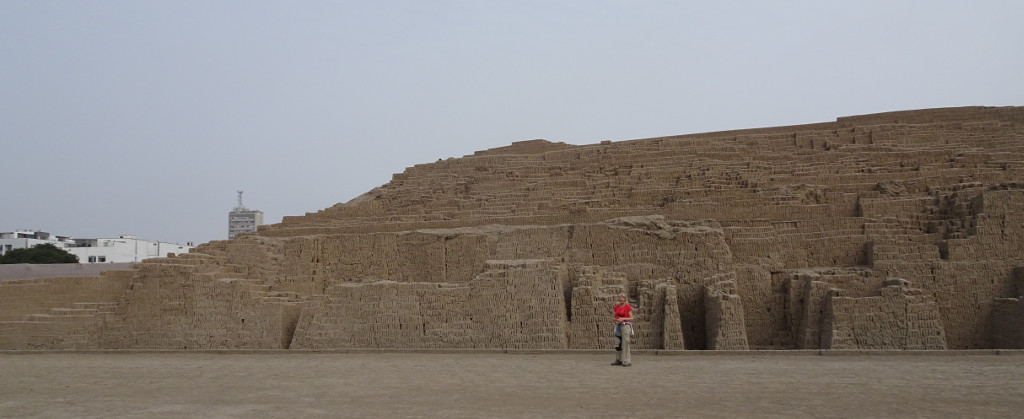Peru Day 10: Cusco to Lima
Confirmed: El Mercado offers the best breakfast of the tour. We ate with appreciation.
Off to the airport. M. and A. shared a shuttle ride and flight with us. They were staying a few extra days in Lima, we would just be staying one. Uneventful flight, collected our bags, farewell hugs to M. and A., and taxi to our hotel in Lima.
Lima. I’m finding it hard to write about it. After ten days in the high country with sun, clear air, friendly people; with sweeping vistas, purposeful people in colorful dress; Lima seemed drab and sterile. Skies were gray. Traffic aggressive, not the intentional friendly buzz and microbeeps of Cusco, just the impersonal outta-my-way city type. Few people walking, and those less present: on their phones, or eyes unfocused. Before I knew it I had fallen into a funk. Why had we come here? Could we just skip Lima and go straight home?
Reframe it, Ed. Find the good. I’ve just now come from downtown (Los Alamos—remember, I’m writing this two weeks later) where I had a chance encounter with A. (Not the A. above). A. has been described as a “master reframer” and we spoke for a while on that. Not about silver linings or making lemonade but of genuine mindset change; of perspective and focus. A. reminded me of who I want to be, and so gave me what I needed to write about Lima. I will acknowledge my gloominess but will not allow it to define my experience there.
Huaca Pucllana
Armed only with a barebones area map provided by our hotel and some suggestions, we sauntered off to see what we could find within walking distance. A mere five or six blocks away was Huaca Pucllana, a giant pyramid being excavated and investigated by archaeologists.
Let me repeat that because I think it’s pretty friggin’ amazing: there is a two-thousand-year-old pyramid right smack in the middle of downtown Lima, next to skyscrapers and residential areas. I’ve been to Segovia; the aqueduct there blew my mind but this did too in a surprising way: somehow it feels completely different when the culture is so… mysterious? Undocumented? Or maybe it’s just the contrast - in Segovia the aqueduct kind of just blended in naturally. I don’t know. I was not prepared for my reaction and still don’t fully understand it.
Entry was inexpensive and they offered tours; we eagerly signed up for the English one. While waiting for our tour we perused their small museum and gaped at incredible and incredibly-preserved pieces of pottery. With minutes to spare I noticed a giant crowd of tourists at the gate, paying and coming in. They did not look like Spanish speakers. I quickly consulted with Ginger, we made a last-minute switch to the Spanish tour. I would spend the tour by her side, listening to our guide with one ear and providing a whispered running translation. It’s work I’ve done before but not in years; I always forget how exhausting it is. But rewarding, too.
“Muy bien. Entonces.” That quickly became our in-joke. It’s how our guide began at every stop: move to a new location; wait for people to assemble; “Muy bien.” Pause. “Entonces.” Pause. And he’d start with his description of the given area of interest. Okay, you had to be there.
The pyramid was begun by the Lima culture, about which not very much seems to be known, circa 200 AD. The Lima were seminomadic, living near the coast part of the year and inland the rest, dwelling in camps but never settling in permanent structures. (Maybe they hated having to dust). The pyramid was a work in progress, continuously used but also built upon over centuries. The Lima’s main goddess was the sea, represented by yellow (don’t ask me; I’m just mindlessly repeating what I heard); the sun was a lesser deity which the sea would snuff out every evening; it was drawn in red. The pottery we saw in the museum earlier demonstrated principally maritime themes.
The higher tiers of the pyramid included tombs but those were not Lima, they were from the Wari who invaded and conquered the Lima ca. 500 AD. The Wari brought their own gods; then the Ychsma conquered and brought theirs; and so on until the Spanish brought their mythology. As far as I can tell they have not yet heard of the Flying Spaghetti Monster.
Amano Textile Museum
Two blocks from Huaca Pucllana is the Amano Textile Museum, a humble-looking building hosting an impressive collection of precolumbian weavings. The lighting was too dim for our old eyes; there was a distractingly monotonous and loud soundtrack from an autorepeat video in one of the halls; yet we quickly found ourselves not caring: the museum was good. Very good. Well laid out, organized, documented, and with exquisite artifacts. We marveled over and over about how much has been preserved and the good condition it’s in. (We may have had low expectations; and of course countless more have been lost or deliberately destroyed. Even so, what still exists is amazing.) We spent less than two hours and came out infinitely richer.
Ambling back to our hotel, the only restaurants we could find were Italian. Finally, a “pollo a la braza” joint appeared. Having heard so much about this rotisseried chicken in Cusco, we gave it a try. I stuck with meatless—cheese tequeños and fried yucca—but then decided, fuck it, to order the anticuchos which U. had urged me to try upon learning I was in Peru. Nodding silent thanks to the dead cow, I set in upon its roasted heart. It was, I’m sad to say, delicious. So was the chicken Ginger ordered.




